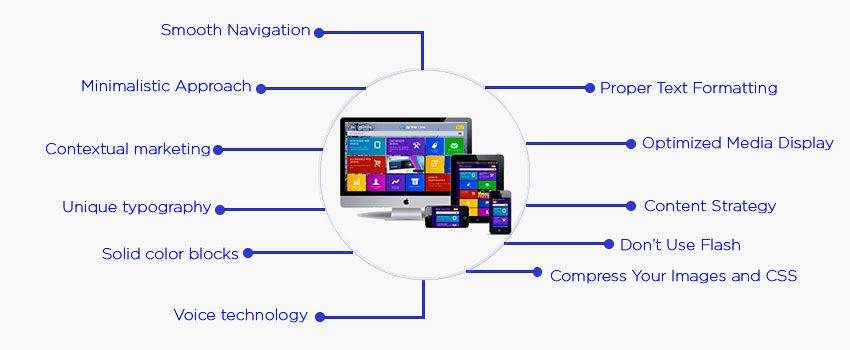Mobile phones have empowered humans, immensely. Now every marketing strategy, graphics, Ad campaigns and content in any form has been specifically designed for mobile users. As there is a major chunk of customers that are accessing sites from mobile phones only. Therefore, it is very crucial to incorporate mobile-friendly features into the websites, so that customer can cherish the smooth, hassle-free navigation experience while browsing your website. Below are the 6 important key features which website owners should follow for a mobile-friendly website.

-
Smooth Navigation
The browsing experience should be great for any visitor which comes to your site. It must be simplified and always visible. Keep the navigation for mobile screens vertical and the space between the navigational elements should be large enough to avoid misclicks.
-
Minimalistic Approach
Keep your website uncluttered. The use of simple colours, shapes, and content appears compelling and continues to interest designers. Strategically use the space, for example, can help simplify your web interface and user interactions with your site, driving home what you consider is the most vital component of your brand’s messaging.
-
Contextual marketing
Implementing contextual marketing, this strategy that presents your website’s content more relevant to each user by produces a more personalized experience.
-
Unique typography
Some businesses have begun using different approaches to typography on their websites to communicate specific messages more loudly, and it appears this fashion will continue in 2020 also. More designs now employ a mix of horizontal and vertical texts, varying size texts, larger and bolder designs, and mismatched fonts. There’s more colour than the conventional one or two in a few designs.
-
Solid colour blocks
For an appealing layout, try employing this idea for your website redesign. Utilizing solid colour blocks can classify your content into even parts and create an appealing design full of vibrant colours, shapes, and more. Simply make sure to align your design organized so your visuals complement one another.
-
Voice technology
Many website experts accept that the use of voice technology across web interfaces, designs, and apps will be widespread in the near future. As more people try out and used voice technology in their everyday life, it’s no surprise that this trend is predicted to be significant.
-
Proper Text Formatting
Keep your content short and break them up with headlines and bulleted lists when it makes sense to include them. It’s hard for human eyes to track close-together lines of text on small screens, so large content makes it more likely that your visitors will lose their place and get frustrated.
-
Optimized Media Display
Test the images, infographics, and videos to assure they look responsive on phones and tablets, without expecting users to scroll or resize their display to see your media.
-
Content Strategy
While designing the content strategy think about how your target audience prefers to read on the phone screen. The content structure should be easy to read as mobile screens are small comparatively. Chunking is an efficient rule to enhance your post structure and make the website more mobile-friendly.
-
Don’t Use Flash
Employing flash on your entire website is an SEO mistake. It can slow down a page’s load time and there are a lot of browsers and devices where it just doesn’t work at all for flash. Android and iOS devices do not support flash, so if you create a website that largely depends on the experience of a Flash animation, your mobile users will be left out. Therefore, it’s best to remove the technology altogether on your website and find a strong web design that works without it.
-
Compress Your Images and CSS
Fast site speed is the utmost crucial demand for mobile-friendly websites. Another good step for making your website mobile friendly is to compress anything that takes up a lot of space and slows loading time, like your high-resolution images and CSS.
By compressing your image file sizes they will load faster without negatively affecting the quality of what people see on the site.
If you looking for some professional team to build the optimized and mobile-friendly website you are at the right place. ImpactInteractive, we have an experienced team of developers who would like to assist you to make your dream website.
